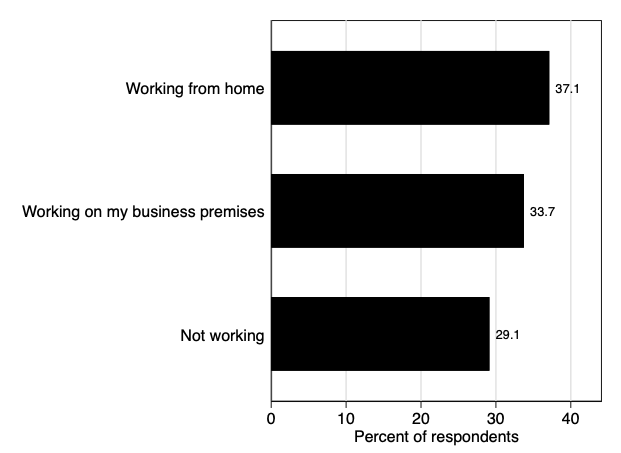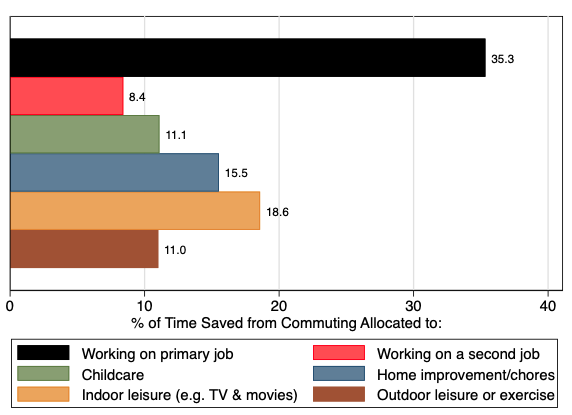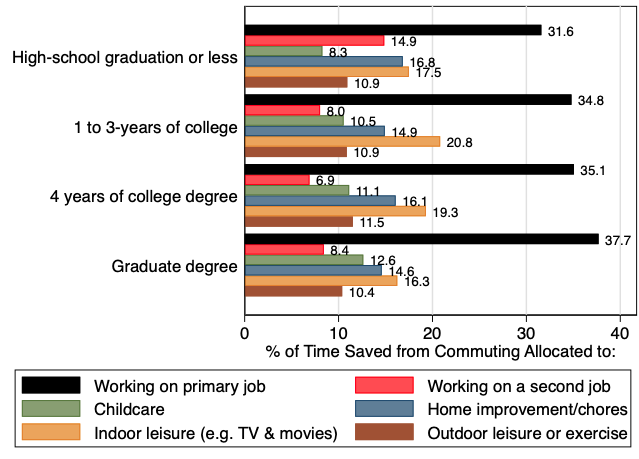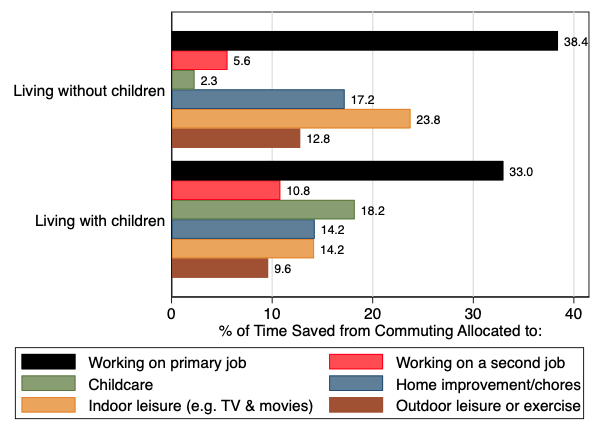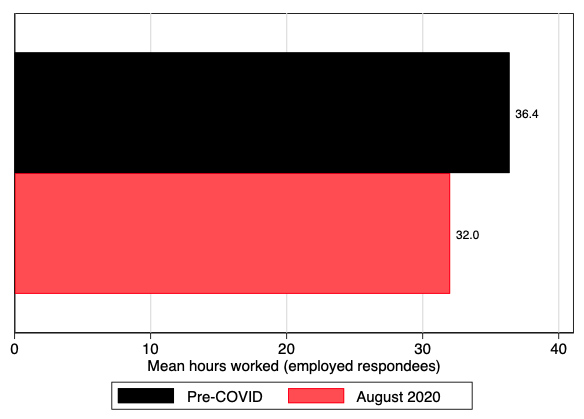The COVID-19 pandemic triggered a sudden, massive shift to working from home (WFH) around the world. There is great concern about how this development will play out over time, whether it will exacerbate inequalities in economic circumstances and how the economy will adjust (e.g. Adams-Prassl et al. 2020, Baldwin 2020, Bartik et al. 2020, Barrero et al. 2020, Berg et al. 2020, Dingel and Neiman 2020, Milasi et al. 2020).
On the positive side, the shift to working from home has already saved billions of hours of commuting time in the US alone. We tap several sources, including original surveys of our design, to quantify this time-saving aspect of the shift and to develop evidence on how Americans are using the time savings (Barrero et al. 2020).
Over May, July, and August 2020, we surveyed 10,000 Americans aged 20-64 years who earned at least $20,000 in 2019. Figure 1 summarises their work circumstances as of the survey date: 37.1% work from home, 34.7% work on business premises, and the rest are not working.
Figure 1 Share of respondents working from home during the COVID-19 pandemic
Notes: Data are from three surveys of 10,000 US residents aged 20 to 64, who earned more than $20,000 per year in 2019, that QuestionPro and Inc-Query carried out in May, July, and August 2020 on behalf of Stanford University. We reweighted the sample of respondents to match Current Population Survey figures by state, industry, and labour earnings.
These figures imply that working from home accounts for 52.3% of employment in the pandemic economy, similar to independent survey-based estimates in Bick et al. (2020) and Brynjolfsson et al. (2020). By way of comparison, American Time Use Survey data imply a 5.2% working-from-home rate among employed persons before the pandemic struck (Barrero et al. 2020).
According to the Current Population Survey, 147.2 million Americans work for pay as of August 2020. According to the 2018 American Community Survey (United States Census Bureau 2018), workers spent an average of 54 minutes per day commuting to and from work before the pandemic.1
Putting the pieces together,2 we estimate that the pandemic-induced shift to working from home yields 62.4 million fewer commuting hours per workday. Cumulating these daily savings from mid-March to mid-September, the aggregate time savings associated with the pandemic-induced shift to working from home is more than 9 billion hours.3
How are working Americans using the time saved by not commuting? To throw light on this matter, our surveys ask:
During the COVID-19 pandemic, while you have been working from home, how are you now spending the time you have saved by not commuting?
a) Working on your current or primary job
b) Working on a second or new secondary job
c) Childcare
d) Home improvement, chores, or shopping
e) Leisure indoors (e.g. reading, watching TV and movies)
f) Exercise or outdoor leisure
We posed two variants of this question. The first asks persons working from home to allocate 100% of the time savings over the six activity categories, and the second asks them to select all categories to which they devote any of their time savings. For the second question variant, we assign equal percentages to each selected category.
Figure 2 summarises the reported allocation of time saved by not commuting. Extra time devoted to the respondent’s primary job absorbs 35% of the time savings. The next largest category is indoor leisure, including reading and watching TV or movies, which absorbs 18%. Childcare, outdoor leisure, and work on a second job together account for about 30%.
Figure 2 How are Americans allocating the time they save by not commuting?
Notes: Among persons working from as of the survey date, this chart reports average responses to the following question: “During the COVID-19 pandemic, while you have been working from home, how are you now spending the time you have saved by not commuting?” Data are from surveys of 5,000 US residents aged 20 to 64, earning more than $20,000 per year in 2019, and fielded during 21-28 August by QuestionPro and Inc-Query on behalf of Stanford University. Sample reweighted to match current Current Population Survey by income, industry, and state.
The picture, then, is one in which those working from home devote most of their savings in commuting time to non-leisure activities: work for pay, but also chores, home improvement, and childcare. Together, these activities absorb about 60% of the time savings.
The primary job absorbs the largest chunk of time savings – around 35% – for both men and women and across groups defined by race and ethnicity. Larger differences emerge when comparing respondents by education, as seen in Figure 3a. Those with a high school diploma or less schooling, devote 32% of their time saving to their primary job and nearly 15% to a second job, almost twice as much as other education groups.
Finally, there is a huge gap between workers who live with children and those who don’t, as Figure 3b shows. Childcare absorbs 18% of time savings among those with children. Still, the primary job absorbs the largest chunk of time savings for both groups, if somewhat less (33%) for workers with children than for those without (38%). Those without children also allocate about 3 additional percentage points of their time savings to outdoor leisure and chores and over 9 additional percentage points to indoor leisure.
Figure 3 How do demographic groups spending commute time saved differently?
a) By education
b) By whether living with children
Notes: Among persons working from as of the survey date, these charts report average responses to the following question: “During the COVID-19 pandemic, while you have been working from home, how are you now spending the time you have saved by not commuting?” The top graph compares education groups, and the bottom chart compares those with and without children under 18 living at home. Data are from surveys of 5,000 US residents aged 20 to 64, earning more than $20,000 per year in 2019, and fielded during 21-28 August by QuestionPro and Inc-Query on behalf of Stanford University. Sample reweighted to match current Current Population Survey by income, industry, and state.
In sum, and looking across a variety of demographic groups, Americans devote one-third or more of their pandemic-induced savings in commuting time to their primary jobs. Leisure and household production activities absorb the rest.
Our surveys also include the following two questions about work hours:
In 2019 (before COVID) approximately how many hours a week did you work when employed?
How many hours per week are you working for pay [now]?
Figure 4 shows average responses to these questions among persons working from home during the pandemic. Hours on the job for these persons average 32 per week in the pandemic economy, as compared to 36.4 in the pre-pandemic economy. This difference amounts to 38 minutes per day, less than the savings in commuting time.4 Since Figure 4 restricts attention to respondents who work from home as of the survey date, these shorter hours do not reflect persons who stopped working during the pandemic.
Figure 4 Average weekly work hours before and during the COVID-19 pandemic, among those working from home in August 2020
Notes: The graph shows the average number of hours worked per week (and 95% confidence intervals) in 2019, before and during the COVID-19 pandemic among respondents who were working from home in summer 2020. Data are from two surveys of 7,500 US residents aged 20 to 64, earning more than $20,000 per year in 2019, fielded in July and August 2020 by QuestionPro and Inc-Query on behalf of Stanford University. Sample reweighted to match current Current Population Survey by income, industry, and state.
How should we square the findings in Figures 2 and 4, namely that those working from home devote one-third of commuting time savings to their primary job while spending less total time in paid employment?
One possibility is that, when respondents answer the question about time allocations, they consider how they use the specific time slot they once spent commuting. Respondents may devote a few more minutes in the morning to chores and childcare, while still devoting about a third of their old commuting time slot to their primary job. At the end of the day, they might end somewhat early and turn on the TV. They might interrupt TV time to respond to a late-afternoon or early-evening work request.
This interpretation is broadly consistent with media reports (e.g. Jacobs 2020), whereby some employees work longer hours from home during the pandemic but with added flexibility to interrupt the day to care for children or perform home chores and other non-job activities. This narrative also fits with our evidence that those working from home spend more than half of their commuting time savings on non-job activities like childcare or leisure.
The COVID-19 pandemic is an enormous healthcare crisis and a source of tremendous hardship for many. At the same time, the pandemic-induced shift to working from home involves a huge reduction in time spent commuting. According to our evidence and calculations, the time savings are approaching ten billion hours as of mid-September for American workers alone. The global reduction in time spent commuting is surely many times larger. Our survey data also say that nearly two-thirds of the savings in commuting time accrue to workers in the form of extra time for leisure and household production activities.
References
Adams-Prassl, A, T Boneva, M Golin and C Rauh (2020), “Working from home: The polarising workplace”, VoxEU.org, 2 September.
Baldwin, R (2020), “COVID, hysteresis, and the future of work”, VoxEU.org, 29 May.
Barrero, J M, N Bloom and S J Davis (2020), “COVID-19 is also a reallocation shock”, Brookings Papers on Economic Activity, forthcoming.
Bartik, A, Z Cullen, E Glaeser, M Luca and C Stanton (2020), “How the COVID-19 crisis is reshaping remote working”, VoxEU.org, 19 July.
Berg, J, F Bonnet and S Soares (2020), “Working from home: Estimating the worldwide potential”, VoxEU.org, 11 May.
Bick, A, A Blandin and K Mertens (2020), “Work from home after the COVID-19 Outbreak”, CEPR Discussion Paper 15000.
Brynjolfsson, E, J J Horton, A Ozimek, D Rock, G Sharma and H-Y TuYe (2020), “COVID-19 and remote work: an early look at US data”, NBER Working Paper 27344.
Dingel, J and B Neiman (2020), “How many jobs can be done at home?”, VoxEU.org, 7 April.
Jacobs, E (2020). “Is it time to cut back our working hours?”, Financial Times, 12 September.
Milasi, S, M Bisello, J Hurley, M Sostero and E Fernandez-Macias (2020), “The potential for teleworking in Europe and the risk of a new digital divide”, VoxEU.org, 14 August.
United States Census Bureau (2018), “American community survey: Commuting characteristics by sex”, online database.
Endnotes
1 This figure reflects employed persons 16 and older who did not work from home.
2 (0.523 – 0.052)(147.2 million)(54/60 hours) = 62.4 million
3 If persons work five days per week and the daily savings in commuting time is uniform throughout the seven-month period, the time savings for employed persons is 9.4 billion hours. This figure does not include the reduction in commuting time due to the pandemic-induced drop in aggregate employment.
4 Recall that our calculation of commuting time savings is over all working persons, while our calculation of reduced hours on the job in this paragraph covers only those working from home at the survey date.




